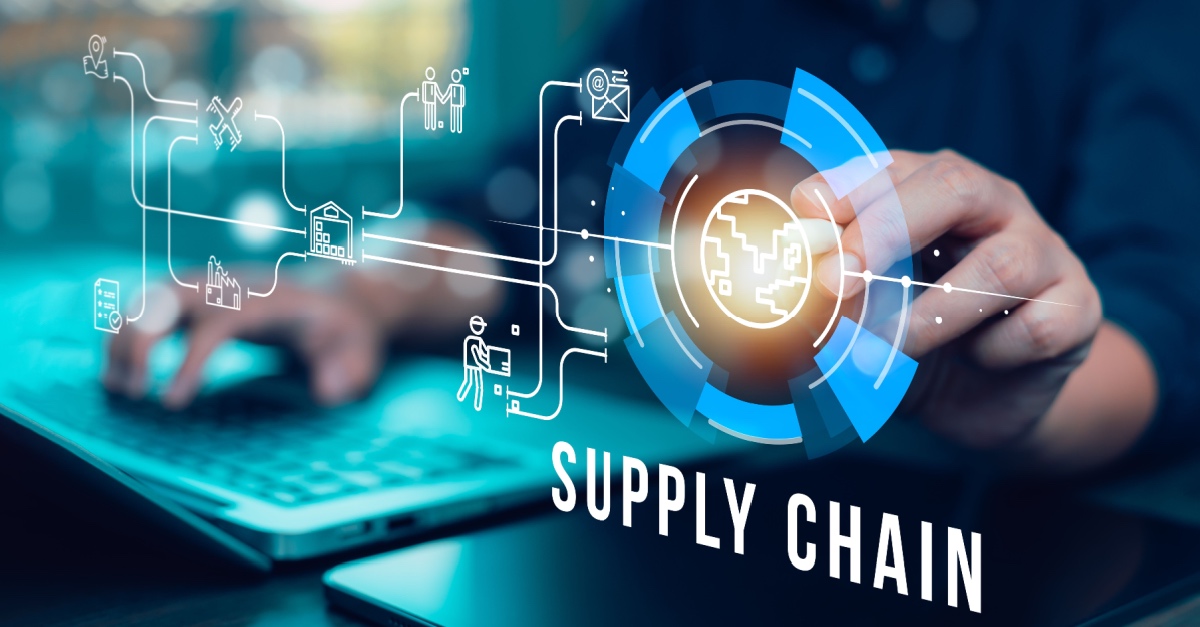
As we’re not yet living in the age of “Star Trek,” where people and things can be transported by breaking down and then reassembling molecules thousands of miles away (Elon Musk: take note), we here on Earth still count on shipping and logistics. By land, sea, and air, massive amounts of cargo are moved every day to keep global commerce humming. And a modern supply chain TMS (transportation management system) is a key technology that helps make it happen more efficiently.
Intelligent shipping combines business intelligence, planning, and execution tools, along with strategy and process, to optimize routing, scheduling, loading, communication, transporter management, etc. There are many primary and secondary benefits, including faster, more accurate deliveries, cost savings, improved customer satisfaction, better driver engagement and retention, and improved inventory management and demand forecasting.
A true supply chain TMS can help you achieve your goal of intelligent shipping by enhancing business intelligence and optimizing all aspects of logistics and transportation.
The Role of Supply Chain Analytics in Global Transport Operations
Supply chain analytics help organizations both keep track of and improve operational performance across various interdependent functions. All of that activity is throwing off tons of data, requiring sophisticated systems to synthesize and analyze, produce insights, and make recommendations. Increasingly, this is done by automating what had been manual processes, such as demand forecasting and route optimization.
The capabilities of supply chain data analytics have advanced significantly in recent years, increasing operational efficiency across all phases of transportation and logistics. For example, modern systems can assess risks associated with everything from geopolitical disruptions and natural disasters to freight capacity and supplier performance. Companies can then develop contingency plans and make better-informed decisions to mitigate these risks.
An advanced supply chain TMS can track KPIs such as the percentage of on-time deliveries, delivery error rate, cost per mile and cost per unit, load utilization percentage, average delivery time, and order cycle time. All of these metrics act as a barometer of business performance and efficiency.
Building Business Intelligence: Supply Chain Analytics Via a Powerful Supply Chain TMS
Tramm, an innovator in supply chain technology, has developed a platform based on the idea that a TMS can only be effective if every aspect of transport management is modeled, integrated, and visible from order inception to final delivery. The end-to-end Tramm TMS platform features route planning and optimization, transporter management, a supply chain control tower, and a powerful mobile app. Comprehensive reporting tools enable strategic planning, and performance analysis and performance management are enhanced via live tempo dashboards, trip scores, and more.
Tramm’s Dashboard Module provides powerful insights built from real-time, integrated external and internal data. Its control tower and visualization module, FleetVision, empowers managers to go from reactive (due to gaps between reported vs. actual performance) to proactive (based on live transportation data). With a better understanding of fleet operations on a granular level, loads are handled more efficiently, freeing up managers to implement performance improvement strategies.
A configurable Order Management module automates order processing, providing detailed visibility into order attributes. Integrated into Tramm TMS for seamless planning and execution, it automatically splits orders based on operational and resource requirements. A client portal allows end customers to capture, manage, and review order status.
Tramm centralizes all supply chain data, improving consistency and accuracy, eliminating discrepancies, and providing a single source of truth. Real-time updates and automated workflows further enhance data reliability, improving decision-making and overall supply chain efficiency.
Three Tactics to Build Business Intelligence through Supply Chain Analytics
To fully leverage the capabilities of a supply chain TMS and enhance business intelligence, companies need to implement specific tactics. Here are three tactics designed to help you achieve these goals, and how Tramm empowers you to do so.
Integrated Supply Chain Analytics
Supply chain analytics need to be woven into every aspect of transportation management. Tramm TMS centralizes data from multiple sources (orders, routes, transporters, etc.), ensuring that critical information is captured and processed in a unified manner.
Tramm eliminates data discrepancies and inconsistencies, creating a reliable, accurate foundation for all decision-making processes. It also provides a comprehensive view of the supply chain, enabling managers to make informed decisions quickly. In addition, internal and external teams have access to the same information, enhancing coordination and cooperation.
Real-Time Data and Insights
Tramm’s TMS and its real-time data processing capabilities allow transport managers to monitor and analyze activities as they happen. Continuous data updates provide a live view from order inception to final delivery, for improved route optimization, tracking, and inventory management.
This capability also allows for proactive identification of bottlenecks and inefficiencies, so managers can quickly implement corrective action and minimize disruptions.
Advanced Reporting and Visualization
Tramm’s supply chain TMS has powerful reporting and visualization tools that turn complex data into actionable insights, helping managers understand and act on key insights effectively.
The platform’s automated reporting on KPIs, such as delivery time, costs, and load utilization, surfaces performance trends and areas for improvement. Tramm’s Dashboard Module translates complex datasets into intuitive graphs, charts, and dashboards to aid decision-making.
Today’s Complex Logistics Call for a Supply Chain TMS That Does More Than Route Shipments
With global freight capacity tightening once again, a volatile market environment, and disruptions the norm, the limited functionality of a legacy TMS isn’t up to the task of managing complex functions across the supply chain.
Tramm TMS leverages the power of advanced analytics, real-time visibility, comprehensive reporting, business intelligence, and performance management tools. With it, organizations can get a better handle on transporter management, improving order flow, optimizing routing, and improving customer satisfaction. To learn how Tramm can transform your supply chain operations, request a demo today.
Related Resources

The Importance of Detailed Order Data in Supply Chain Optimization
As supply chains become increasingly complex, the demand for efficiency and flexibility has never been greater as companies struggle to meet rising customer expectations and deal with global disruptions. Having detailed order data is one key ingredient in supply chain optimization, enabling better decision-making, improved efficiency, and reduced costs.
The ability to access and analyze clean, accurate data improves demand forecasting, inventory management, and fulfillment operations by providing greater visibility into SKU levels and order status. It also helps streamline transportation, reduce lead times, and optimize carrier selection.
Conversely, a lack of detailed order data leads to a variety of negative consequences. These include mismanaged inventory (more stockouts, overstocks), fulfillment delays, disrupted workflows, inaccurate demand forecasts (over or underproduction), strained customer relationships, and financial impacts.
This is why order data accuracy is critical in supply chain optimization. It improves decision-making, enhances efficiency, and reduces costs.
Understanding Order Data’s Role in Supply Chain Optimization
Order data includes information on products, quantities, prices, customer preferences, delivery schedules, and fulfillment status. Sources of order data include order management systems (OMS), enterprise resource planning (ERP, often the central hub), customer relationship management (CRM), procurement systems, and, if there’s a retail component, point-of-sale (POS) systems.
Detailed order data is the foundation for optimizing inventory management, transportation and delivery, warehousing, and fulfillment — in short, every operational aspect of the business.
An inability to control how orders are handled from inception contributes to poor decisions, and inaccurate data is often the culprit. The lack of a unified, efficient system for moving orders from planning to execution and doesn’t enable real-time visibility is a recipe for disaster. The result is a limited ability to represent actual order status in a meaningful way.
Enhancing Demand Forecasting and Inventory Management
A business’s success or failure is inextricably linked to its ability to accurately forecast demand and, from there, properly manage inventory levels. Detailed order data (current and historical), as well as factors like market trends and customer feedback, allow businesses to predict demand more accurately and optimize inventory levels.
Using manual processes to handle order data, even in small-to-medium businesses, is a system rife with errors and inaccuracies. The ability to access real-time order data informs smarter reordering and replenishment strategies. This helps reduce overstocks or out-of-stocks by leveraging actual demand patterns, maintaining cash flow, reducing carrying costs, and keeping customers happy.
Improving Order Fulfillment and Reducing Lead Times
Having detailed order data helps minimize fulfillment errors by optimizing picking, packing, and shipping processes. By accurately tracking customer demand, businesses can expedite order processing and optimize transportation routes to reduce lead times.
Order allocation can be fine-tuned based on stock availability and proximity to customers, enabling faster, more efficient fulfillment. This not only speeds up deliveries but also improves customer satisfaction.
Optimizing Transportation and Logistics
Another benefit of having detailed, accurate order data is on the logistics side. With it, businesses can optimize order routing, consolidate shipments, and reduce delivery costs. They can also choose the most cost-effective carriers and shipping methods based on order data.
Order consolidation involves centralizing items from multiple orders into a single location or by combining multiple orders from different sales channels into a single system. This helps lower transportation costs, improve inventory management, simplify logistics, and provide a better customer experience by reducing split shipments.
With the ability to access and analyze detailed order data, businesses can save by taking advantage of bulk shipping discounts, optimizing carrier selection, and avoiding last-minute changes in shipping schedules.
Supporting Customer Satisfaction and Personalization
Detailed order data allows businesses to track customer preferences, providing personalized offerings and recommendations. It also improves proactive communication, informing customers about order status, estimated delivery times, and potential delays.
This type of transparency enhances trust and helps companies to manage customer expectations. It contributes to a consistently excellent customer experience, boosting satisfaction scores, repeat business, and brand loyalty.
Without Detailed Order Data, Things Break Down
Detailed order data is critical for supply chain optimization, enabling better demand forecasting, more efficient inventory management, and faster fulfillment. It allows businesses to streamline transportation, optimize routing, and reduce delivery costs. Accurate order data also supports customer satisfaction by providing real-time order status and personalized offerings, reducing errors and improving efficiency. A lack of such data, for instance, due to manual processes or outdated software, leads to fulfillment delays, inventory mismanagement, and strained operations.
Tramm, a developer of a leading unified supply chain management platform, combines a powerful OMS within its transportation management system (TMS) suite. This integrated approach provides end-to-end visibility and control over order fulfillment and shipping processes. Tramm’s Order Management Module ensures that orders are fully consolidated before being released for shipment, while the TMS manages transportation in the most efficient, cost-effective manner.
The power of Tramm lies in its ability to optimize the entire process from order management through planning and route optimization, contract management, fleet management, and performance analytics. A versatile driver app provides workflow management, electronic proof of delivery, compliance tracking, and auditing.
Request a demo today to learn more about how Tramm can drive supply chain optimization through its cutting-edge tools and holistic approach.

Sustainable Logistics: How Optimized Routing Can Reduce Your Carbon Footprint
The world of logistics and transportation cannot afford to slow down, and the trend toward sustainable logistics is working hard to catch up. Demand for shipping and delivery services is only increasing in a fast-moving, interconnected global economy. But with this growth comes greater pollution levels from vehicles and logistics networks.
For this reason, it shouldn’t be surprising that 75% of logistics companies have a focus on sustainability, according to a May 2024 survey by the Germany-based Logistics Hall of Fame. A majority of respondents rated the risk of financial loss due to climate change as “medium to high.”
This is why major efforts are underway to reduce trucking-generated pollution by implementing a sustainable logistics program. These include efforts to optimize routing, grow alternative fuel fleets, increase the use of automation, enforce stricter emissions standards, and ramp up intermodal transportation.
Optimized routing, in particular, has emerged as a powerful tool to not only reduce transportation costs but also significantly minimize carbon emissions, making logistics operations more sustainable.
The Environmental Impact of Logistics
Transportation contributes more than a third of all CO2 emissions globally, with nearly two-thirds of that coming from trucking, according to the International Energy Agency (IEA). In addition, transportation relies on petroleum products for nearly 91% of its energy, down just 3.5 percentage points from the early 1970s.
Excessive fuel usage in everything from long-haul trucking to last-mile delivery, traffic congestion, and poorly planned routes contribute to higher CO2 emissions. At the same time, regulatory pressure and consumer demand for more sustainable business practices are forcing companies to adapt.
The Basics of Route Optimization
Route optimization tools use advanced algorithms and predictive analytics, parsing historical and real-time data to identify the most efficient delivery routes. Factors taken into account include traffic conditions, weather, vehicle capacity, delivery windows, and road restrictions.
Many routing tools within a transportation management system (TMS) also include load optimization capabilities, enabling companies to maximize their available freight capacity and improve key metrics like revenue per mile, cost per delivery, and fleet utilization.
State-of-the-art route optimization tools employ dynamic multi-day route planning and scheduling across trucking modes, everything from LTL, TL, middle mile, last mile, private fleet and dedicated transportation services.
Reducing Fuel Consumption and Carbon Emissions
As route optimization enables companies to reduce the number of miles driven, an immediate, tangible benefit is a significant saving on fuel consumption.
These tools also allow drivers to avoid areas of traffic congestion, helping to improve on-time delivery performance. This not only reduces truck dwell time and, thus, tailpipe emissions, but also increases customer satisfaction.
By optimizing load capacity, companies can put fewer trucks on the road, further reducing fuel usage and emissions — further driving sustainable logistics.
The Role of Real-Time Data in Sustainable Routing
Access to real-time data on traffic, weather, and road conditions allows for dynamic rerouting to avoid delays and minimize emissions. Traffic data can come from GPS systems and platforms like Google Maps or Waze for information on congestion, accidents, and road closures.
Weather data from apps like The Weather Channel or OpenWeatherMap provide updates on conditions (thunderstorms, high wind, fog, snow) that might affect a trip, rerouting if necessary. Telematics and sensors take in data on vehicle location, speed, fuel usage, and status from onboard systems or fleet management software.
Updates from order management systems (OMS) on delivery windows and customer availability also become part of the routing equation, as does data on weight or height restrictions and road closures from transportation departments. Routing software also tracks fuel efficiency and vehicle performance, reducing environmental impact.
Other Benefits of Route Optimization
In addition to reduced fuel consumption and lower operating costs, route optimization enables faster, more reliable deliveries, improving customer relationships and fostering loyalty.
Optimized routing also helps companies meet their environmental goals through sustainable logistics. This includes compliance with government regulations and qualification for certifications such as LEED, ISO14001, and SmartWay.
Route Smarter, Stay Greener
Route optimization improves logistics efficiency and plays a crucial role in reducing carbon emissions. An investment in this technology helps drive both sustainability and competitiveness in a business climate that increasingly values environmental responsibility. By embracing sustainable logistics practices through the use of these tools, companies can reach their goals while driving down costs through efficiency gains.
Tramm, an innovator in supply chain technology, has developed an end-to-end TMS platform that combines route planning, load building, transporter management, a supply chain control tower, and a powerful mobile app. With this end-to-end approach, Tramm has solved the problem of fragmented supply chain systems by integrating key functions into a unified, scalable platform.
Tramm’s Planning and Optimization Module handles complex routing environments, accounting for variables such as rules and constraints that accurately reflect on-the-ground transport operations. It allows users to easily adapt their plans based on changing needs, including “what if” visualization and scenarios that enable real-time adjustments. A load builder/stackability app lets them automatically plan loads that are tightly synced with capacity and route optimization.
To find out how Tramm’s unified approach can drive transportation efficiency and cost savings while helping you realize sustainability goals, request a demo today.

Synchronized Logistics: Leveraging An Integrated TMS for Real-Time Supply Chain Management
An integrated supply chain TMS helps make tight partner collaboration and data collection from multiple sources possible so goods flow smoothly, SLAs are hit, and production stays on track.
It’s also a key element in synchronized logistics, a process that businesses lean on to manage multiple complex systems. This involves pulling together and analyzing data from disparate sources, all of which touch the supply chain in some way: transportation management systems (TMS), warehouse management systems (WMS), enterprise resource planning (ERP), and even yard management systems (YMS). Using data analytics, synchronized logistics pulls together insights that can then be applied to various supply chain processes.
In this context, an integrated supply chain TMS can achieve synchronized logistics by enhancing business intelligence and optimizing all aspects of transportation. This, of course, has multiple benefits up and down the supply chain, such as faster inventory turns, better delivery metrics, and improved asset utilization, among others.
An integrated TMS uses advanced business intelligence to optimize logistics and transportation by analyzing large sets of real-time and historical data. It helps identify patterns and inefficiencies, predict delays, and recommend optimal routes. Using predictive analytics to forecast demand can optimize capacity utilization and automate decision-making, such as selecting the most cost-effective carriers or adjusting delivery schedules.
An integrated TMS enables more precise planning, cost control, and supply chain efficiency by incorporating data from ERP, WMSs, and other systems. This helps companies improve planning and execution, reduce delays, and respond quickly to disruptions. Using AI-powered data analytics, businesses can fine-tune their operations and keep costs in check.
As the need for real-time supply chain visibility grows, the role of an integrated supply chain TMS becomes even more critical. Its ability to synchronize logistics and provide actionable insights helps companies stay competitive in an increasingly dynamic market.
What is an Integrated TMS in the Supply Chain?
An integrated TMS is a comprehensive platform designed to streamline the core functions of supply chain management: planning, execution, and optimization of transportation activities. It helps businesses plan efficient routes, execute shipments, and optimize delivery schedules to reduce costs and improve performance.
It also helps meet heightened performance expectations by providing visibility and agility across the supply chain. Unlike a traditional TMS with limited connectivity, an integrated TMS hooks into multiple complementary software systems. Creating a cohesive information flow across the supply chain enables more informed decision-making and better cross-functional collaboration. Businesses benefit from real-time tracking, updates, and greater visibility into logistics operations.
The Importance of Real-Time Supply Chain Management
Customers in both B2B and B2C are demanding faster delivery times, more accurate ETAs, tight delivery windows, and real-time updates on order status. Call it the “Amazon effect,” driven by the higher service level expectations created by the mega e-commerce company turned logistics powerhouse. Especially in a tighter economy, there is little margin for error in terms of costs, the balance sheet, and customer churn.
Real-time supply chain management involves continuously monitoring and managing supply chain activities as they happen. This is where synchronized logistics comes into the picture. Real-time data from integrated systems provides immediate visibility into inventory, shipment status, and fulfillment operations. This allows businesses to make quick, informed decisions, optimize routes, and adjust to changing conditions. The result is increased efficiency, cost savings, and improved customer service.
Key benefits of real-time supply chain management include:
Quick response to disruptions: Real-time supply chain management enables businesses to respond swiftly to issues like traffic, port congestion, or weather delays. With immediate access to updated data, they can quickly adjust routes, reschedule shipments, and notify customers, minimizing delays and maintaining operational efficiency.
Optimized route planning: Real-time data from TMSs allows businesses to dynamically optimize routes based on current conditions such as traffic or road closures. This reduces transit times, improves fuel efficiency, and enhances on-time delivery rates, leading to cost savings and improved KPIs.
Improved customer satisfaction: Accurate real-time tracking ensures customers receive up-to-date information on shipment status, including greater accuracy in delivery estimates. This transparency and proactive communication build trust and loyalty by enhancing customer experience (CX), helping companies exceed delivery expectations, and improving customer satisfaction.
Core Features of an Integrated TMS That Supports Synchronized Logistics
An integrated supply chain TMS offers a wide array of features designed to improve supply chain management and logistics flow:
Real-Time Tracking and Visibility
A supply chain TMS allows you to monitor each shipment from order to delivery by providing continuous updates on shipment location, inventory status, and delivery progress. This level of transparency allows you to quickly address potential issues (delays, misrouting, breakdowns) before they escalate. The system’s ability to provide real-time views into supply chain flow improves accountability and efficiency.
Advanced Data Analytics
Integrated TMS platforms use predictive analytics to anticipate delays, optimize routes, and improve decision-making. Predictive and even prescriptive insights allow businesses to proactively avoid disruptions and refine logistics strategy.
Automation and Collaboration
Automation tools facilitate freight scheduling, real-time communication with carriers, and stakeholder collaboration. This reduces manual intervention and enables teams to focus on higher-value tasks.
Seamless Integration
An integrated TMS connects with other systems to synchronize supply chain operations. This ensures data flows smoothly between departments, teams, and partners, helping streamline processes and reduce delays.
Overcoming Common Supply Chain Challenges with Integrated TMS
An integrated TMS helps businesses address several common supply chain challenges:
Reducing delays and inefficiencies: Real-time updates allow companies to anticipate and avoid delays. With real-time visibility, businesses can reroute shipments or adjust schedules to minimize disruptions.
Improving demand forecasting and inventory management: Data generated by a TMS helps logistics planners maintain lean inventories while still meeting customer demand. With accurate, up-to-date information on shipment status and inventory levels, they can more closely align supply with demand, reducing the risk of stockouts or overstocking.
Adapting to market changes: Market volatility and changes in consumer behavior can disrupt supply chains. An integrated TMS helps businesses become agile through real-time adjustments to routes, carriers, or schedules in response to changing conditions.
The Role of Data in Synchronized Logistics
Data is the backbone of synchronized logistics. An integrated TMS collects, processes, and analyzes vast amounts of data to drive more informed decision-making.
A TMS provides real-time data, enabling better decision-making in procurement, route optimization, and warehouse management. Accurate, timely information helps businesses be more proactive and improve overall efficiency.
Many advanced TMS platforms incorporate AI and machine learning algorithms to predict risks, optimize freight rates, and automate repetitive tasks. These technologies enhance the system’s ability to make real-time adjustments, delivering improved operational efficiency and reduced costs.
By leveraging real-time data, businesses can provide more accurate information to customers about shipment status, improving transparency and loyalty. Data-driven synchronized logistics enhances CX by ensuring timely deliveries and proactive communication.
Choosing the Right Integrated TMS for Your Business
Some attributes of an integrated TMS include its intuitive UI, which makes it easy for nontechnical users to manage both owned and contracted transportation assets. This includes streamlining aspects of transportation management, such as contracts and payments.
Scalability is another important feature, as well as a cloud architecture and ease of integration with other systems through API connections. A supply chain TMS should also be customizable and rules-based, adaptable to prioritize the execution of last-mile delivery, international shipping, or retail replenishment. Mobile workflows, master data attributes, exception management, self-reporting, and business intelligence should all be easily configurable based on your business needs.
The importance of provider reliability cannot be overstated. Look for a company that offers robust customer support, ongoing training, and regular system updates to address evolving industry and business needs. This is a recipe for long-term success, giving you the ability to maximize system capabilities.
An Integrated TMS: Creating the Future of Supply Chain Efficiency
An integrated supply chain TMS plays a pivotal role in powering synchronized logistics so businesses can streamline operations and respond in real time to supply chain challenges. Consolidating data from multiple systems enhances visibility, optimizes routes, and minimizes disruptions. Companies can make informed decisions, improve delivery performance, and reduce costs through advanced analytics and automation. These next-generation systems ensure a more agile, efficient, and customer-centric supply chain.
Tramm TMS is the first SaaS platform using advanced technology to enable companies to easily manage all transportation assets, both owned and third-party, from the first mile to the last mile.
It is purpose-built to streamline supply chain operations, synching data to create a single source of truth. By eliminating data silos and tapping the power of AI-driven insights, Tramm streamlines processes and ensures a consistency of action across the supply chain.
With its modular, scalable architecture, Tramm’s solution set includes an order management system (OMS), a visibility and control tower module, a global transporter module, a dashboards module, and a driver app. Its platform marries flexibility with optimization, powering a customer-centric approach that delivers measurable results. To learn more about Tramm’s ability to power synchronized logistics and increase supply chain efficiency in your organization, request a demo today.

Why Real-Time Data is Crucial for Optimizing Transport Operations
Transport operations the world over work hand-in-glove with manufacturing to power the world economy. Millions of tons of goods are moved daily by land (truck and train), sea, and air across vast distances to enable international trade and commerce.
The importance of data in transport operations cannot be overstated. It empowers companies to make better decisions, run more efficiently, send and receive shipments on time and (hopefully) reduce costs in the process.
Real-time data, in particular, plays a critical role in optimizing transportation operations. When run through analytical engines, it fuels up-to-the-minute insights into vehicle and container locations, traffic and weather conditions, and many other factors, enabling dynamic adjustments.
Data Provides Quantitative Insight into Complex Transportation Operations
Real-time data is defined as information that is delivered and processed immediately upon collection, allowing for quick decisions based on events as they happen. This type of data is particularly important in industries like global transport and logistics, where conditions affecting transit times are constantly changing.
Traditional data management relies on historical information from the prior day, week, month, quarter, or year. As such, companies employ various analytical methods to develop forecast models on which business decisions are based. Having access to real-time data significantly augments and enhances traditional data management, as it provides a view of actual conditions, activities, and transportation flows.
Tackling the Complexities of Managing Transport Operations
You may have heard that managing transport operations, especially those involving the movement of freight, is incredibly complex. And you would be right. Whether operating a private fleet, dedicated transport, or using third-party carriers, managing booking, routing, scheduling, loading, unloading, maintenance, etc., while keeping within budget is challenging.
Considering all these moving pieces, the high costs, and how business success relies on successful transport execution, the ability to access real-time data becomes that much more critical. Here are some of the key benefits.
- Enhanced decision-making: by leveraging real-time data analytics, transport operations managers have access to the latest information for faster, more accurate decision-making. From the ability to do dynamic routing and scheduling to load optimisation and asset utilization, there are all kinds of benefits that accrue.
- Improved operational efficiency: By enabling real-time tracking and monitoring of shipments, transport managers get instant visibility. Optimized routing and scheduling reduce fuel consumption and improves on-time delivery performance, lowering costs and improving service reliability.
- Increased visibility: Stakeholders such as shippers, customers and logistics partners can access up-to-the-minute information on transit times, ETAs, service disruptions, and performance vs. plan. This transparency improves customer satisfaction and aids in continuous improvement planning.
- Proactive issue management: Through early detection and alerting to potential disruptions, transportation managers can quickly enact contingency plans, setting in motion alternative routes and backup carriers to resolve issues before they escalate.
Real-Time Data in Action: How It Transforms Transport Operations
By leveraging real-time data, fleet managers go from being reactive and contending with potential gaps in information between reported vs. actual activity to being proactive and equipped with meaningful information that helps them improve performance.
Real-time data analytics is the fuel behind Tramm. An innovative transportation management system (TMS), Tramm’s suite features planning and route optimisation, transporter management, real-time visibility, and actionable business insights. It helps fleet managers elevate their operations internally and for customers.
Real-Time Vehicle Tracking and Status Updates
Tramm’s FleetVision module leverages real-time data from both onboard GPS and a proprietary driver app to continually track the location of every vehicle in the network. Users can also monitor how trips, loads, and shipment status are progressing vs. plan, get a live look at operational tempo, and automatically issue alerts on any plan deviations.
By monitoring every activity and status in real time, Tramm helps logistics and fleet managers make fast, informed decisions, adjusting routes to avoid delays while improving overall fleet efficiency.
Dynamic Route Optimisation
Tramm’s Route Optimization and Planning module dynamically adjusts routes based on its ability to monitor a range of factors. This allows for a continuous recalibration of delivery schedules and routes, making your transportation plan a model of efficiency and cost-effectiveness.
The system provides immediate feedback on things like running behind on a delivery window or a potential product-vehicle or vehicle-site mismatch. Managers are also notified in real time about vehicle utilization status. By continuously displaying these types of key insights, Tramm helps reduce fuel consumption, minimize delays, and optimize resource allocation.
Real-Time Performance Analytics
Tramm’s Dashboard module integrates real-time data analytics to offer comprehensive insights into network performance. Logistics and transportation managers can view live performance metrics, such as delivery times, operational flow, vehicle bunching, utilization rates, and schedule adherence.
Through powerful analytics, Tramm lets managers identify trends, pinpoint inefficiencies, and implement data-driven strategies to enhance operational performance. They are now empowered to respond swiftly, improving overall network reliability.
In Dynamic Transport Operations, Data Is the Differentiator
A hyper-connected supply chain, with shippers, carriers, freight forwarders, and fleet managers all dependent upon one another, needs real-time data to create a single source of operational truth. It is a true difference-maker, separating successful, highly efficient operations from those struggling to maintain SLAs and KPIs.
Each component of Tramm’s integrated TMS suite utilizes the power of real-time data to drive performance gains in managing transport operations:
- FleetVision Module: Provides live tracking of the planned vs. actual status on vehicles and loads, plus performance analysis, live predictive ETAs, and comprehensive exception management via a control tower view.
- Dashboard Module: A comprehensive data analytics/reporting tool that allows for analysis and data manipulation of the planned versus actual and historical data in the system to help you hit SLAs and drive continuous improvement.
- Mobile App: Provides real-time driver job assignments and updates plus ePOD (proof of delivery) and customizable operational workflow management on the go.
- Order Management: Rules-based order processing automates things like order splitting based on operational and resource requirements, designated delivery days and windows.
- Route Optimization: Handles complex routing scenarios and accounts for the details of each variable, like rules and constraints to accurately reflect actual operations.
- Transact: An easier way to manage loads, Transact allocates carriers based on preset rules and provides visibility into status, while automatically applying complex tariffs.
A Key Capability For Optimizing Transport Operations
Real-time data drives smarter, faster decision-making, improved efficiency, and greater supply chain visibility. It can help you stay competitive and address market challenges and disruptions as they arise.
Tramm’s innovative platform provides powerful capabilities that can transform your fleet operations into a leaner, more responsive, and performance-driven network. Request a demo today!





